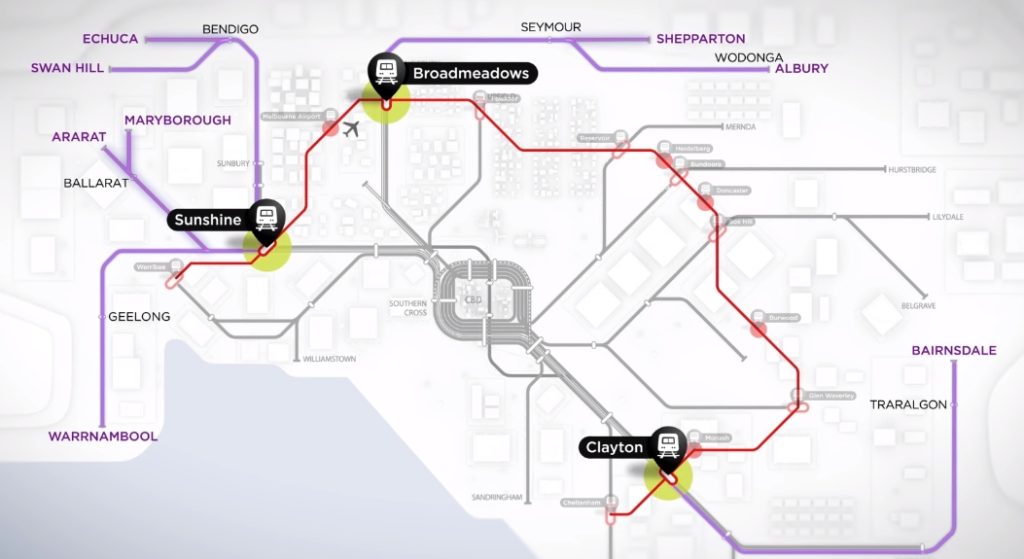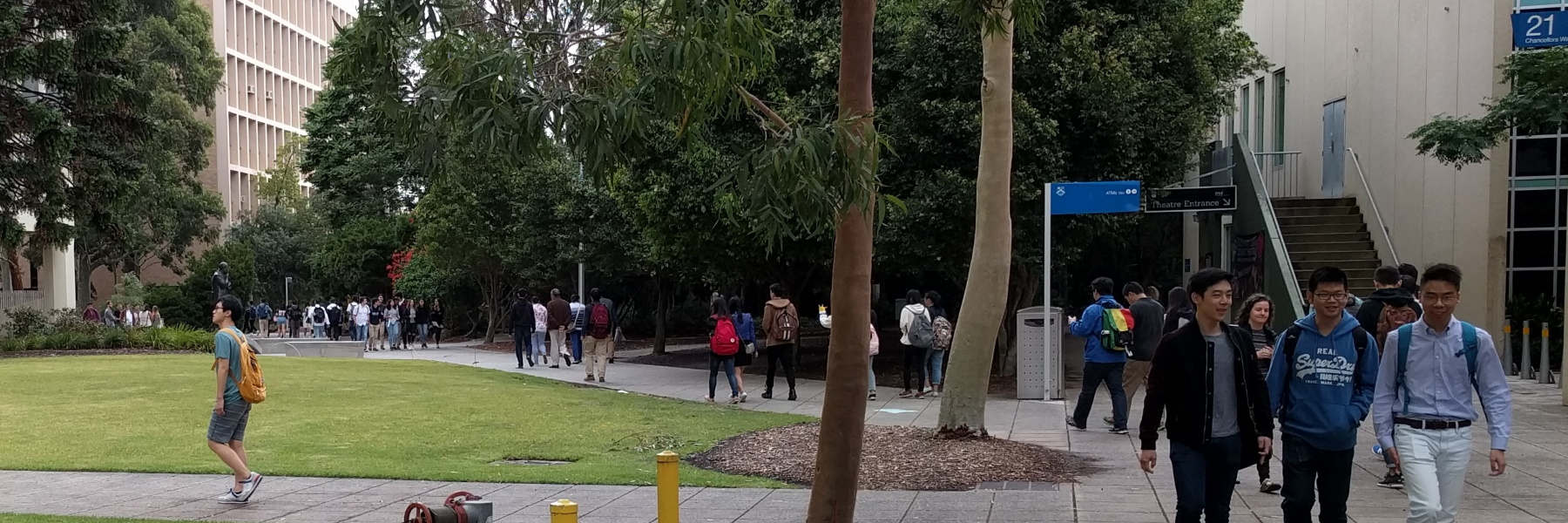One of the things people have been wondering is whether the Suburban Rail Loop will be an integral part of the existing suburban Metro network, or a standalone line.

Melbourne’s existing rail network has its origins in the 1854 line from Port Melbourne to Flinders Street (since converted to trams), but also particularly in the electrification of the 1910s and 1920s, to the standards of the time, including 1500 volt DC power.
While the SRL will have many interchanges with the existing network, there’s no particular reason it has to use the same technology.
The State Government announced on Sunday that SRL will indeed be different.
Similar to the NSW decision to make their new Metro line independent of the double-deck suburban lines, the SRL will be completely separate from the suburban network.
From the press release:
It will be built as a separate rail line, meaning it can use state-of-the-art systems from around the world without having to retrofit technology into the existing network – saving time and money.
Passengers will be able to easily transfer across both networks, with the same ticketing system servicing both and up to 12 new stations connecting the existing rail system with the new standalone line.
SRL as a completely separate rail line brings a number of advantages.
Smaller, shorter trains running to higher frequencies can be used – better meeting the non-tidal capacity requirements of a line that doesn’t serve the CBD, while providing real Turn Up And Go services that make interchange from other lines and modes quick and easy.
The key would be to provide infrastructure that makes it possible to easily scale-up capacity as demand grows.
Nobody wants a repeat of the tram 96 situation, where the conversion from high capacity heavy rail to medium capacity light rail, combined with population growth, has seen heavy crowding, with demand swamping the trams.
A segregated fleet means platform screen doors can be used at every station, improving safety.
(Platform screen doors are flagged for the metro tunnel as well, though theoretically could also be retro-fitted at most stations between Sunbury and Cranbourne/Pakenham – with the possible exception of platforms shared with V/Line. And full platform shelter might be required to make it work.)
Smaller trains may mean a smaller loading gauge, helping to reduce tunnelling costs… or indeed the potential to use standard gauge tracks.
Modern AC power can reduce costs as well – as I understand it, fewer substations are needed compared to the 1500 volt DC power used by suburban trains.
If the line is completely grade separated and independent, it also means driverless trains are possible. Again, the new Sydney Metro line uses these, as do an increasing number of urban train services around the world, including parts of the Singapore MTR, Vancouver’s Skytrain, and London’s DLR.
At this stage the Government seems reluctant to commit to full automation.
Of course there are some disadvantages from using different technology.
Fleets could not be exchanged with other existing Melbourne lines, limiting flexibility. The deployment of new vehicles, and the cascading of others around the network is common on some networks, including Melbourne’s trams.
These types of factors become less important as the network gets bigger. Overall it seems to make sense the way they’re going. The pros outweigh the cons.
I’m more concerned about them adding some intermediate stations (or at least future provision for them) to the longer stretches of the route, to help ensure plenty of people have access to the line.
Given the apparent wish to seek private investment, it would make sense to have stations at some locations which are not already developed to a high density.
There is also a strong argument for including Doncaster in the first section (currently flagged as Cheltenham to Box Hill) given Doncaster is one of Melbourne’s biggest centres with no rail connection.
Provision for a future connection from Cheltenham to the Sandringham line would also make sense.
And there are still questions about the Airport section of the line, connecting through to Sunshine. I suspect Sunday’s announcement means SRL trains will share the alignment with City to Airport trains, but use separate tracks – but given that’s SRL stage 2 or 3, that decision is a long way off.
It’s good to see the Suburban Rail Loop progressing. It looks like we can expect to see construction begin by 2022 – just in time for the next state election.
As it comes into service, it will revolutionise cross-suburban travel by providing fast frequent connections around the middle-distance suburbs – opening up opportunities in jobs and education.
It does mean it becomes even more important to reform and upgrade bus routes and service frequencies to help more people easily reach the rail network.
And building the SRL is not an excuse for not providing 7-day all-day frequent services on the suburban trains – as well as progressing other major rail infrastructure such as Metro 2.
Our growing city needs it all to help more people get around without adding to the traffic.



11 replies on “SRL will be an independent line”
It should be done as sky rail, not a tunnel.
Jeremy, the outer parts of the Sydney Metro are skyrail.
It works quite well with the existing rail network. Minimal delay and frequent trains.
If you have a senior/pensioner Opal card you can travel all day for $2.50 on ferry/trains/trams/and buses, excellent value. We recently caught the train from North Ryde to Kiama a distance of 125km for $2.50 return.
The proposed Melbourne metro loop should start at Sandringham.
Train passengers wanting to go to Monash Uni would have to travel to Richmond, change, train to Clayton?, change, then metro to Monash.
For the sake of a few extra kms of tunneling all the major Melbourne rail lines would be linked.
Why hasn’t the Andrews Govt included Sandringham? Is it political? Unlike the Liberals, Labor should be better than that.
I would imagine it’s largely about patronage. You’re only getting interchange passengers from on direction. Same is true obviously for Glen Waverley but it’s a much more significant destination in its own right, and effectively en route. No reason a bus rapid transit connection down Bay Road couldn’t provide a high quality connection into SRL at significantly lower cost. That’s not to say project planning shouldn’t safeguard future extension
There should be intermediate stations where areas can be significantly upzoned without NIMBY opposition, such as the low-rise industrial areas just north of Monash Uni Clayton, and just south of Latrobe Uni Bundoora. Some of the construction costs could be offset by charging a special rate on occupied floor area, similar to the levy that helped pay for the City Loop. These areas could become the new South Yarra’s or Southbank’s, or like Sydney’s North Ryde office area. Each new intensive suburb would save the massive infrastructure costs of low-rise sprawl.
Yes it could use different technology without being a problem – look at the São Paulo monorail metro for instance. But overall this seems such a wast of money. We need a metro that runs like a metro with a service every 2/3min not the overcrowded 20/10min we have now, most lines are running antiquated signalling, same with the packed trams – we need more of them. We have a good system that’s not being made the most of because it’s starved of cash by a government that wants to spend billions on this. This seems more like a political gimmick than proper transport investment.
Hi Daniel, thanks for the thoughtful article. Do you, or the PTUA have any suggestions for where intermediate stations could be located?
@Malcolm: I hope by “intermediate stations” you don’t mean glorified tram stops like the Lilydale/Belgrave line already has, where every second station (Laburnum, Mont Albert, Chatham, East Camberwell and Auburn) seems to exist solely for lazy people who can’t walk 5-10 minutes to the main station a few hundred metres away.
@Shayne: We have a proper metro system, it’s not the antiquated signalling that causes the train system to be infrequent, it’s the antiquated owner of the rail system (hint, it’s not Metro Trains Melbourne) that is the problem. Duplicating the remaining single-track sections (including single-platform stations e.g. Ashburton and Alamein, or Sandringham) would be an order of magnitude better than some of the more pointless level crossings that were done, which were of course only done to improve roads; the stations being rebuilt during the LXRA/LXRP was simply a side effect of the works being done (note that the dilapidated wooden-sleepered tracks between the level crossing jobs are still as noisy and rough as ever).
I’m a big fan of using standard infrastructure and design for this project as the the projected cost is going to be one of the issues.
Using the bespoke infrastructure like broad gauge tracks and other unique attributes of our train network is more likely to increase the cost of delivery as there is going to be less vendors who can do the job, so the costs will go up with that sort of custom order.
A good project to look at is the Sydney Metro North West, which provided 15km of twin tunnel, 8 new stations and various other things for 8 billion. Now Melbourne does gave a different geology but I still feel that the Suburban rail loop people could learn a lot from the project.
I’m really opposed to the idea of the government changing the colour of the train for no (seemingly valid) reason. It should remain blue, without a “SRL” logo to differentiate it from others. Let it be whatever gauge is best for tunnelling/cost, whatever rolling stock is best, etc, but keep the “brand” the same as the rest.
@Paul
I agree, I just hope we don’t alter the rolling stock too much where its the ugliest of its kind (like Sydney did with the Alstom Metropolis). Amsterdam, Buenos Aires and countless others managed to buy the ones that don’t look crap.
Id say, that Glen Waverly is quite a detour from the straight line that would run between Monash and Box Hill. Is this a good idea?